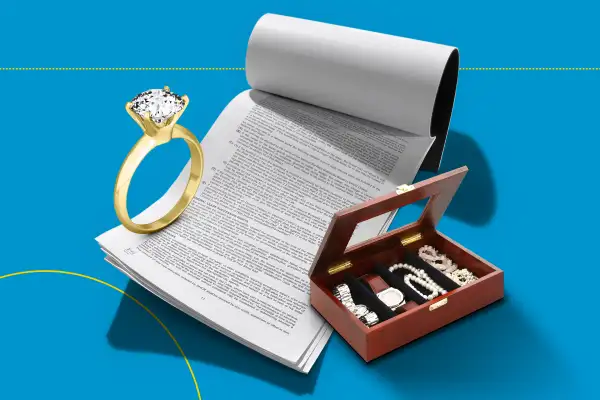How to Make Sure Your Most Valuable Possessions Are Fully Insured

The holiday season gifted you with a new Rolex or a Tiffany necklace. You splurged on a painting. You inherited your grandmother’s prize jewelry collection. If you have items at home that are valued in the four figures, make sure those possessions are fully covered by your homeowners insurance. In doing so, you may even add policy features you didn't know you lacked now, like coverage for accidental damage.
Big-ticket acquisitions are especially common at the end of the year. Among 1,700 Americans surveyed by Harris Polls on behalf of carrier Selective Insurance, 53% received a holiday gift in 2020 that was worth $1,000 or more. That's the dollar cap on claims per item with many policies, meaning you may need to upgrade your coverage to have your valuables fully covered.
Limitations in your insurance could mean you aren't protected -- at least fully -- against damage or loss of the most cherished items you own. Here’s how to take care of that vulnerability.
Add items to a home inventory
If you don’t document the valuable items in your home for insurance purposes, you should, according to the Insurance Information Institute.
The trade group recommends documenting possessions in several forms of media. That involves collecting and storing information on the price you paid, serial numbers, and other particulars. Hard copies should be supplemented with images, including either still photos or a video of the items, perhaps captured during a walk-through of the home with your phone camera. A digital copy of both the printed material and images should be stored outside the home, perhaps through being uploaded to an off-site cloud storage service.
As you acquire further expensive items, add them to your inventory immediately after they arrive in your home. Otherwise, warns Allen Anderson, SVP and Chief Underwriting Officer at Selective Insurance, the item may not be fully covered, even if you have a special rider that covers the type of item in question.
Check values against your policy’s per-item limit
Now you need to confirm how well you’re insured for your prize possessions. Your overall coverage for the contents of your home likely won’t be a problem, since those limits are usually in the hundreds of thousands of dollars. But homeowner or renters policies usually limit the value of claims for any one item.
With a typical cap of $1,000 or $1,500, that provision could leave you short of fully covering the most valuable artworks or jewelry pieces you own. If in doubt about their value, consider getting these possessions appraised. Jewelry appraisals can cost $50 to $150 an hour, according to Jewelry Mutual, a specialty insurer, or be priced per item. Art appraisals can begin with online guides to approximate value or involve engaging an art appraiser at a fee for a more reliable estimate, according to the Smithsonian Institute.
Add policy riders for specialty items as needed
If you indeed own items that exceed the limit, or even suspect you do, a rider to your policy will allow you to make sure you are fully covered for them.
You buy riders for the specific categories of items you require. Pricing varies from between 50 cents to $4 per $100 of coverage, depending on the insurer and what it is you're trying to insure, according to online insurance broker Insuramatch. So a jewelry rate of between $1 and $2 per $100 would cost $50 to $100 a year to, say, insure a couple of necklaces worth $2,500 each.
Such a premium cost, incurred year after year, may seem pricey simply to cover the gap between the maximum claim per item on your regular insurance and the full value of the item. (In the example of the necklaces, that gap would amount to $1,500, assuming a $1,000 per item cap in the regular policy.)
Enjoy bonus features with the riders
Rider may include several additional provisions that could save you money. For one, a rider will allow you to skip paying the usual claims deductible on your policy, says Anderson. Many homeowners have chosen to increase those amounts in recent years, to reduce their premiums, he notes, with deductibles of $1,000 and up increasingly common.
Returning to our example, then, the loss of one of those $2,500 necklaces would yield a settlement of only $500 from a regular policy that had a $1,000 deductible and a $1,500 limit in claimed value per item. A policy with a jewelry rider, by contrast, would provide you with the full $2,500 value of the piece.
Riders can additionally cover perils that your regular policy does not, Anderson says. A case in point, he says, is accidental damage or destruction of the item, which may not not be covered at all in the regular policy, even to the policy’s low per-item limit. “If your kid knocks over that expensive vase, there's no coverage for that, unless you have [accidental coverage] scheduled within a rider.”
He also cites what the insurance industry terms as “mysterious disappearance,” as in the loss of an item in a way that can’t be proven as theft. Under a regular policy, a valuable piece of jewelry that, say, fell off and was never found during a night out probably wouldn’t be covered under a regular policy, he says. But a jewelry rider would likely do so, provided the insurance company was satisfied that the claim was honest and genuine.
Riders can be added or updated at any time, Anderson says. And he recommends consultation with your insurance agent to discuss the possibilities and options when it comes to coverage for specialty items. “An agent can really do a very good job of advising a customer on how best to handle some of those situations.”
More from Money:
Best Homeowners Insurance Companies of 2020
Insuring A Second Home Is Surprisingly Expensive. Here’s How To Cut Premiums
